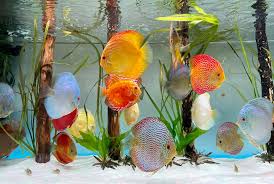1
/
of
1
Midwest Aquarium and Pond Supplier LLC
(177) Large Discus 4.5-6in
(177) Large Discus 4.5-6in
Regular price
$149.99 USD
Regular price
Sale price
$149.99 USD
Shipping calculated at checkout.
Quantity
Couldn't load pickup availability
Caring for discus fish, the "Kings of the Aquarium," requires attention to detail regarding water quality, temperature, and diet. While demanding a higher level of care than many community fish, captive-bred discus are adaptable and very rewarding to keep.
Essential Water Parameters
Pristine, stable water conditions are crucial for discus health.
- Temperature: Maintain a consistent temperature between 82°F and 86°F (28°C-30°C). Higher temperatures (86°F-88°F) are often used for growing juveniles to speed up their metabolism, while lower temperatures (around 82°F) can help stimulate breeding or are used in heavily planted tanks.
- pH: Discus generally prefer soft, acidic water (pH 6.0–7.0). However, most captive-bred discus can thrive in a wider range (up to 7.6 or 8.0) as long as the pH is stable and does not fluctuate rapidly.
- Hardness: Soft to medium hardness (1° to 4° dKH) is ideal, but stable conditions are more important than hitting exact numbers.
- Ammonia/Nitrite: Must be at 0 ppm.
- Nitrate: Keep below 20 ppm for non-planted tanks and below 40 ppm for planted tanks.
Tank Setup and Maintenance
- Tank Size: A minimum of 55 gallons is recommended, but a 75-gallon or larger is better. The tank should be relatively tall (at least 18 inches high) to accommodate their body shape.
- Filtration: A robust, reliable filter (like a canister or sump filter) is necessary. Discus do not like strong water current, so flow should be gentle.
- Water Changes: Regular, frequent water changes are vital. A weekly change of at least 20-40% is standard for adult fish in a display tank. Growing juveniles require more frequent changes, sometimes daily, due to a higher feeding schedule.
- Substrate/Decor: Bare-bottom tanks are easier to keep clean, which is why they are often used for growing out fish or breeding. For display tanks, a fine sand substrate is suitable, along with smooth driftwood and hardy plants (like Anubias or Java Fern) that tolerate warmer water.
- Lighting: Discus prefer subdued lighting.
Diet and Feeding
Discus are omnivores and need a varied, high-quality diet for optimal health and color.
- Variety is Key: Offer a mix of high-quality flakes, granules, frozen (e.g., bloodworms, brine shrimp), and live foods.
- Frequency: Adult discus should be fed 2-3 times per day. Growing juveniles need 4-6 smaller feedings per day.
- Quantity: Feed only what they can consume in a few minutes, and remove uneaten food to maintain water quality.
Social Behavior and Tank Mates
Discus are social fish and should be kept in groups of at least 6-8 individuals to mitigate territorial aggression. They are peaceful but can be slow eaters, so tank mates must be non-aggressive, handle the high temperature, and not outcompete the discus for food.
Suitable tank mates include:
- Cardinal Tetras
- Rummynose Tetras
- Corydoras Catfish (especially Sterbai corys)
- Small plecos (like Bristlenose
Share
No reviews

